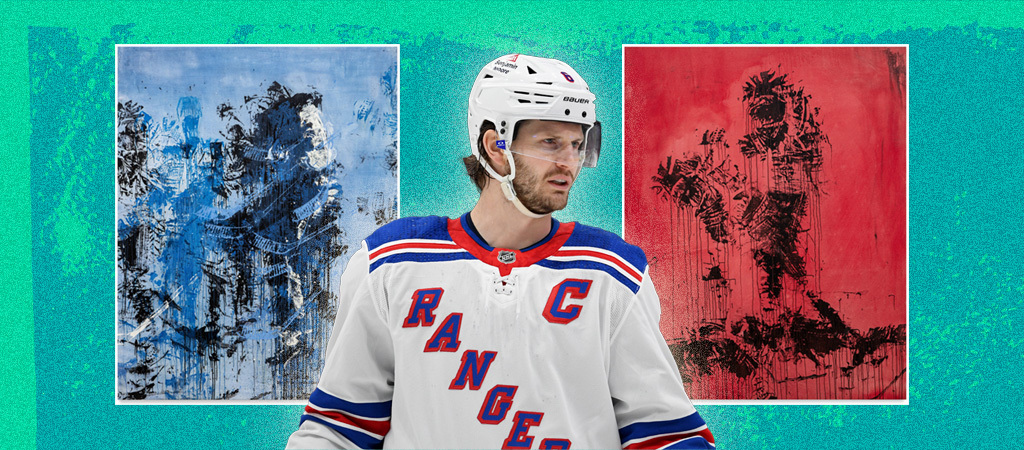Jacob Trouba has a look of bewilderment in his eyes. We meet at Harper’s Gallery, in the Chelsea neighborhood of New York City, for his “Landing My Mark” exhibition opening. Trouba emanates self-assurance, but this is unfamiliar territory. The New York Rangers captain isn’t fazed by thousands of people watching his every move on the ice, but he never imagined his artwork would be up for public consumption.
“I didn’t set out to have a gallery show when I started,” Trouba, 30, says. “This is the first time people have viewed them in person — the first showing [outside of] friends and family at our apartment. I was never out to sell art. That was never the goal.”
Three summers ago, Trouba set out to find an offseason hobby. He doesn’t watch television, and, as he says now, “I suck at golf.” Michael Geschwer, a friend since Trouba had been traded from Winnipeg to New York in 2019, invited Trouba to his art studio. “I said, ‘I’ll go for three days and give it a try,” Trouba says. Initially, Trouba’s goal was to paint something his wife, Dr. Kelly Tyson-Trouba, would want hanging on their apartment walls. “Because it was impossible,” Trouba says, flashing a grin. “There was no way I could have painted something that she would’ve let me hang in the house. So, I was like, ‘Oh, I’m gonna do it.'”
At Geschwer’s studio, Trouba didn’t know what to do with the paintbrush in his hand. He tried painting Kelly and their dog. “I wanted to go home. I was horrible,” he says, adding, “I was very close to being like, ‘This just isn’t for me.'”
Then, Trouba remembered who he was. He had made his name on the ice as a relentlessly physical defenseman, selflessly launching his body to inflict punishing hits in pursuit of something greater. A couple of weeks later at Geschwer’s studio, Trouba realized he had overlooked his favorite tool for self-expression: His body.
Trouba suited up in his hockey gear, doused in oil and acrylic paint, and launched himself onto a wall-length canvas. “Leap Of Faith,” Trouba’s first painting, was born.
“I remember stepping back and looking at it, like, Whoa, this is awesome. I can do something with this,” Trouba says. “You make marks, and then you figure it out. You can change them. Nothing’s permanent. I think that was when I was like, so I can make this line, I can fix it, or do something else? It’s not there forever. You want it to be done quickly, and it just doesn’t happen quickly. So, [I had to] get over that hurdle of this isn’t going to be done today, tomorrow, or this week; this is going to be months.”
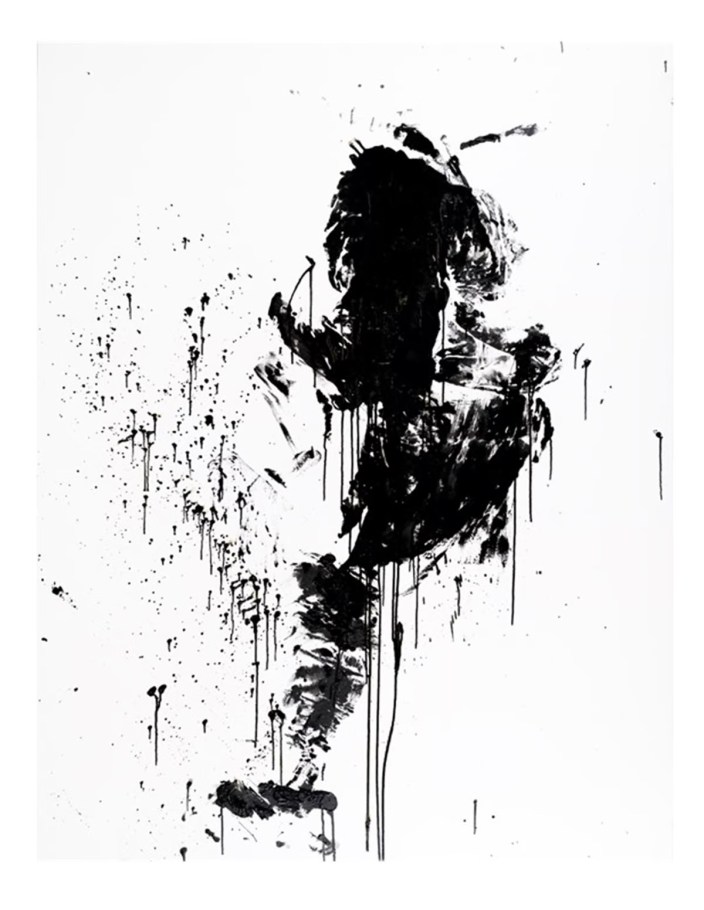
Trouba’s hockey career was already a testament to his dedication to seeing something through, no matter how long it takes. Trouba rooted his identity in hockey as a kid in Rochester, Michigan, and excelled for one season at the University of Michigan before the Winnipeg Jets snagged him ninth overall in the 2012 NHL Entry Draft.
Anyone could have seen Jacob Trouba, NHL star, coming.
Nobody saw Jacob Trouba, the artist, coming.
Trouba never drew attention to it. His teammates didn’t grasp it until a Trouba painting was auctioned during New York Rangers Casino Night in February. The same month, Trouba custom painted the backplate of Rangers goaltender Jonathan Quick’s mask for the 2024 NHL Stadium Series. Slowly, Trouba invited friends and family to the studio and opened up to them, which he describes as “nerve-wracking,” but they encouraged him to keep sharing his art.
“Jacob never really showed any artistic interest in his adolescence, which is why I was so surprised when he told me he was painting,” says Kristy Trouba, Jacob’s mother, with whom Jacob became a face for AstraZeneca’s “Get Body Checked Against Cancer” campaign. “He spent most of his time concentrating on school and hockey. When most of his friends were inside playing video games, Jacob would be out in the garage shooting hockey pucks against a shooting tarp.”
She adds, “Not surprising to me, however, is the fact that he has been so successful in this endeavor. One thing I know to be true is that, once Jacob sets his mind to something, he gives it 110 percent and is generally very successful.”
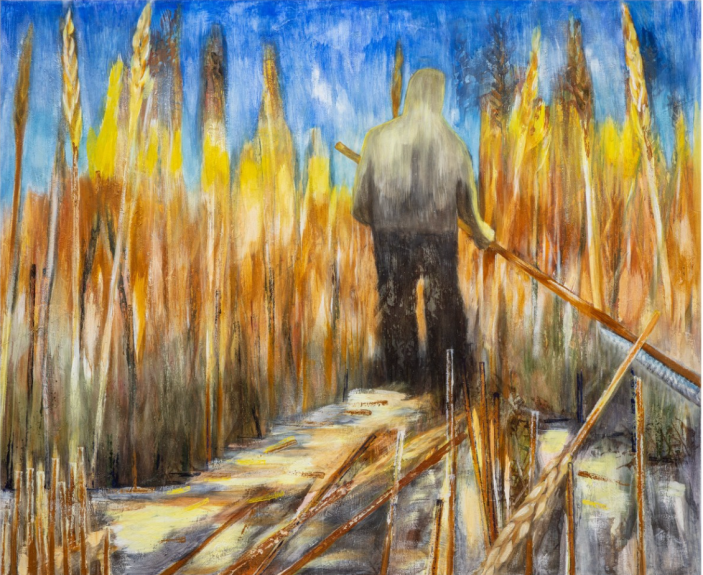
Yes, Trouba was finally successful in winning over Kelly, his wife of five-plus years, with an all-brush painting depicting their relationship. She hung it in the nursery for their infant son, Axel. “Actually, the baby loves it,” Trouba says. “When you walk by it, he stares at it, which is great.” But Trouba is proudest of how painting widens his scope to give back.
“The charitable aspect is much more fulfilling than my art hanging in someone’s house,” Trouba says.
In June, Trouba reacted to PGA Tour golfer Grayson Murray’s death by suicide by donating that month’s print sales to Athletes For Hope and estimates it amounted to $10,000, and will continue as an ambassador for the foundation. At Harper’s Gallery, Trouba donated one painting to be auctioned off as part of his partnership with NHL’s Hockey Fights Cancer. The Rangers star also pulled from personal experience when founding the Trouba Creative Expressions Arts Program with Kelly, who suffers from epilepsy. The program connects adults with epilepsy with art therapists.
Trouba mostly speaks very matter-of-factly and self-deprecatingly about what he repeatedly refers to as simply “a hobby” that he “enjoys spending time doing” throughout our conversation. “I don’t view it as some crazy thing I’m trying to accomplish,” he says. But someone needs to say it: Trouba’s artwork helps people by simply existing. He doesn’t paint for a reaction, but he’s been touched by watching people’s reactions change — their minds opening to new perspective in real time — when he explains his intention behind a piece.
“I was interested in what makes a piece of art good,” Trouba says, referencing his mindset three summers ago. “Why is that one better than this one? That was the original question I had. I’m not perfect at art in any way imaginable and probably never will be. It was more about the challenge of, you’re a hockey player; you can’t be an artist. You’re not supposed to do this. The challenge more than perfection.”
Harper Levine, founder and owner of Harper’s Gallery, didn’t dismiss Trouba as a hockey player after seeing his blue and black “Arrival And Departure” painting online. Levine, a Rangers fan, was watching a game last December when his daughter blew up his phone: “Dad, Jacob’s a good artist!”
“I started looking at his feed, and I couldn’t believe what I saw,” Levine says. “I was immediately struck by the blue painting, and it’s inescapably a great painting. You wouldn’t be able to create a compositionally sophisticated painting like Jacob has done if you didn’t have some real inherent great chops as an artist. He has no formal training, so he has an innate artistic sense that he probably was born with. It’s just amazing that someone who has such a high-profile day job is also so good at this.”
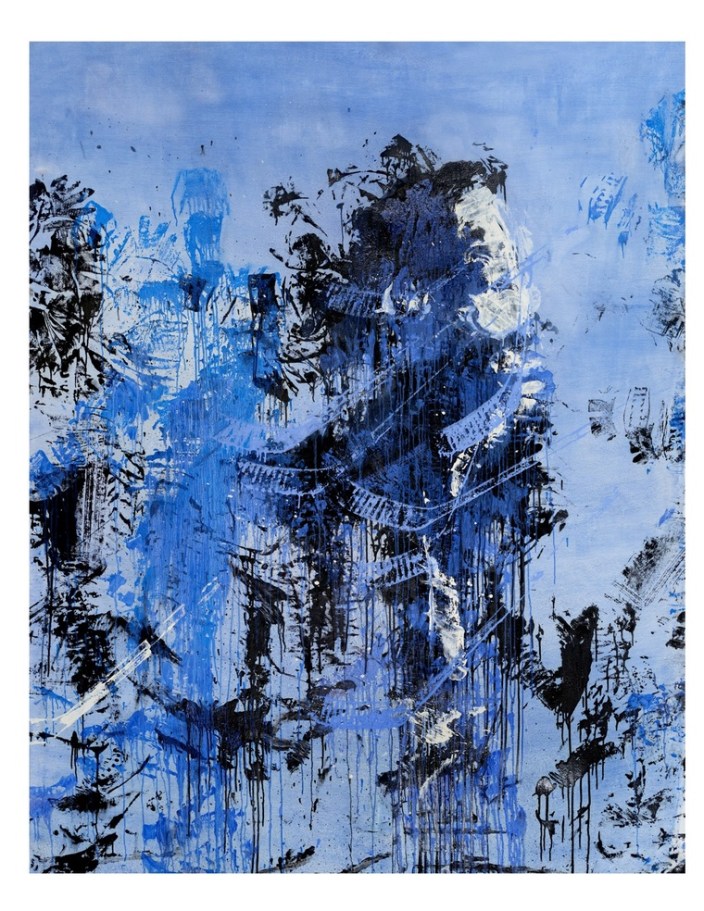
Trouba is a naturally distinguishable artist because, consciously or subconsciously, painting reframed his day job and his relationship with his body. With Geschwer, Trouba attached to art by studying the basics of marks, lines, and washes. He eventually recognized that his hockey hits were more than hits. His body had value outside of what it could do for the Rangers, and he owed it to himself to explore the unique marks his body could make as his brush.
“It really shines a light that athletes are not one-dimensional people,” Levine says. “Athletes are objectified. One of the reasons why, from an art standpoint, this is so interesting is there was a famous artist named Yves Klein who did body paintings, but he used a model. Jacob used his own body for self-liberation.”
Levine continues, “Because Jacob is known as a hockey player — a very tough, old-school, and very physical hockey player — this is a way for him to channel those things that he brings on the ice into something completely different so that folks recognize that it’s not what they think it is. His hits can be channeled into something else that’s really poetic and intrinsically non-violent.”
Trouba notes that “hitting will still be incorporated” in his artwork, but he emphasizes that “there’s more to explore.” He feels like a kid again — indulging his curiosity and competitive nature, free from the weight of results.
“I’m expanding the artistic language while still bringing it back to hockey,” he says. He points toward a light and dark blue painting called “The Center” hanging in the opposite corner. “The only blue dot on the hockey rink is the center-ice dot, but it’s not just a blue dot. I skated over it, made my lines, and it encompasses the center of my universe.” Hanging in another room is “Wheat Field,” which Trouba painted this summer by smacking his hockey stick against the canvas to maintain a hockey element while allowing for growth into more traditional brushwork. In the process, he is preserving his hockey identity.
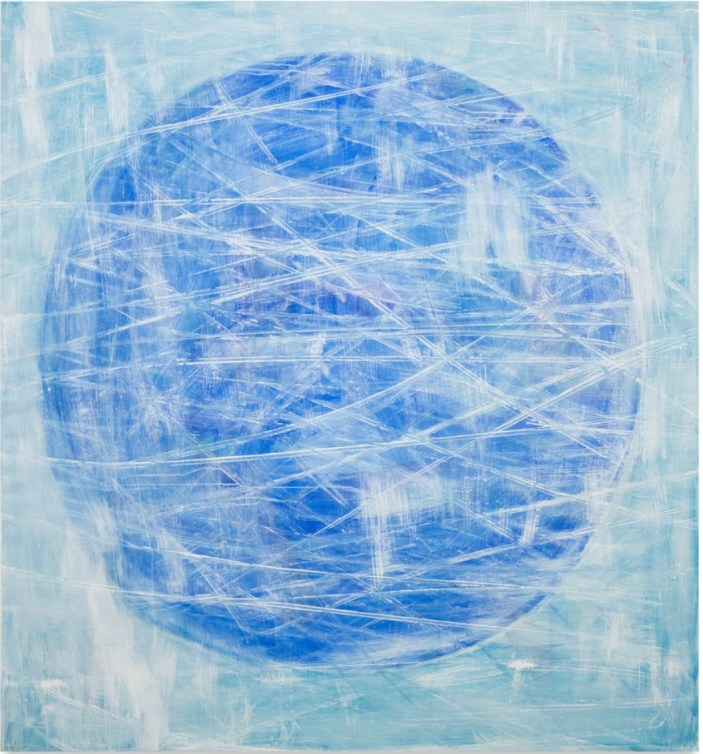
When asked whether he finds relief in knowing he can paint forever as opposed to inevitable athletic mortality, Trouba flinches. He laughs before saying, “I don’t know. I don’t like to think about the end of hockey.” Although, he admits, “Maybe the running into the wall will expire at some point, but there is no expiration date on painting.”
This month, an untold number of people have walked by Harper’s Gallery and seen Trouba’s “Arrival And Departure” hanging in the window — the same painting that prompted Levine to initiate this gallery showing. Many of them probably had a visceral reaction like Levine did. “Arrival And Departure” may not have been as striking if Trouba had ignored his gut feeling that it wasn’t finished. He had walked away from it for a week, assuming it was done, before suiting up and hitting it again. Selflessly pushing his body in pursuit of something greater. He shook off angst that he’d ruined it and added white emulsion. He responded to his marks until they told him the painting was done.
Now, “Arrival And Departure” symbolizes what will drive Trouba long after his “Landing My Mark” exhibition exits Harper’s Gallery on August 24.
“I can do what I want to do, change it if I don’t like something, paint over it, let it dry, and paint it white again — you can do anything,” he says. “In hockey, winning is that feeling you chase. Painting is kind of the same thing. A finished painting is something you’re proud of. You leave the studio, and you’re like, ‘Oh, I love it.’ You feel happy. If you just like it, you’ve got to keep working on it. Nothing you don’t love is finished. Everything in here, I love.”

